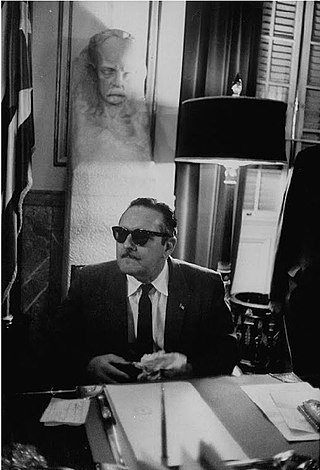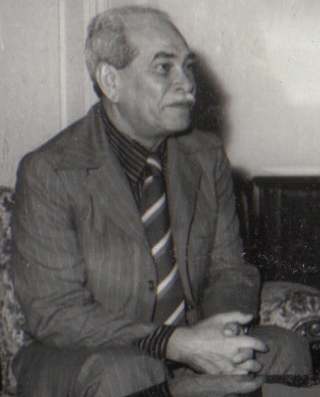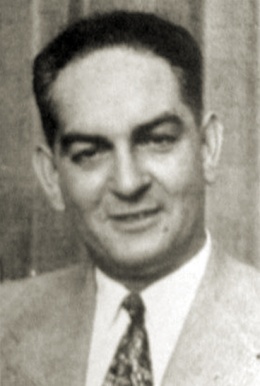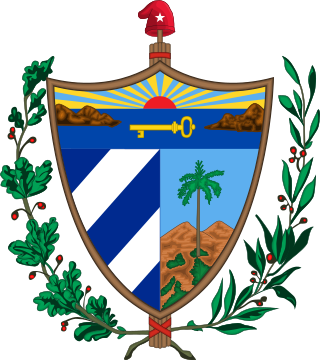
Fulgencio Batista y Zaldívar was a Cuban military officer and politician who played a dominant role in Cuban politics from his initial rise to power as part of the 1933 Revolt of the Sergeants until his overthrow in the Cuban Revolution in 1959. He served as elected president of Cuba from 1940 to 1944,and military dictator from 1952 to his 1959 resignation.

The Cuban Revolution was the military and political overthrow of Fulgencio Batista's dictatorship,which had reigned as the government of Cuba between 1952 and 1959. The revolution began after the 1952 Cuban coup d'état,which saw Batista topple the nascent Cuban democracy and consolidate power. Among those opposing the coup was Fidel Castro,then a novice attorney who attempted to contest the coup through Cuba's judiciary. Once these efforts proved fruitless,Fidel Castro and his brother Raúl led an armed attack on the Cuban military's Moncada Barracks on 26 July 1953.

The 26 July Movement was a Cuban vanguard revolutionary organization and later a political party led by Fidel Castro. The movement's name commemorates the failed 1953 attack on the Moncada Barracks in Santiago de Cuba,part of an attempt to overthrow the dictator Fulgencio Batista.

Manuel Urrutia Lleó was a liberal Cuban lawyer and politician. He campaigned against the Gerardo Machado government and the dictatorial second presidency of Fulgencio Batista during the 1950s,before serving as president in the revolutionary government of 1959. Urrutia resigned his position after only seven months,owing to a series of disputes with revolutionary leader Fidel Castro,and emigrated to the United States shortly afterward.
This article gives an overview of liberalism in Cuba. It is limited to liberal parties with substantial support,mainly proved by having had a representation in parliament. The sign ⇒means a reference to another party in that scheme. For inclusion in this scheme it isn't necessary so that parties labeled themselves as a liberal party.

Rolando Arcadio Masferrer Rojas,better known simply as Rolando Masferrer,was a Cuban henchman,lawyer,congressman,newspaper publisher and a political activist.

Eduardo RenéChibás Ribas was a Cuban politician who used radio to broadcast his political views to the public. He primarily denounced corruption and gangsterism rampant during the governments of Ramón Grau and Carlos Prío which preceded the Batista era. He believed corruption was the most important problem Cuba faced.

The Cuban Revolutionary Party –Authentic,commonly called the Authentic Party,was a political party in Cuba most active between 1934 and 1952. Although the Partido Auténtico had significant influence,it eventually became unpopular due to corruption scandals and,despite significant reforms,Fulgencio Batista returned to power after a coup d’etat.
The Cuban Revolution was the overthrow of Fulgencio Batista's regime by the 26th of July Movement and the establishment of a new Cuban government led by Fidel Castro in 1959.

Diario de la Marina was a newspaper published in Cuba,founded by Don Araujo de Lira in 1839. Diario de la Marina was Cuba’s longest-running newspaper. Its roots went back to 1813 with El Lucero de la Habana and the Noticioso Mercantil whose 1832 merger established El Noticioso y Lucero de la Habana,which was renamed Diario de la Marina in 1844. In 1895,Don Nicolás Rivero took over as the 13th director of the publication and transformed it into the widest-circulated newspaper in Cuba. Though a conservative publication,its pages gave voice to a wide range of opinions,including those of avowed communists. It gave a platform to essayist Jorge Mañach and many other distinguished Cuban intellectuals.

Miguel Ángel Quevedo y de la Lastra was the publisher and editor of Bohemia,the most popular news-weekly in Cuba and the oldest Latin America,known for its political journalism and editorial writing.

Cuba has suffered from widespread and rampant corruption since the establishment of the Republic of Cuba in 1902. The book Corruption in Cuba states that public ownership resulted in "a lack of identifiable ownership and widespread misuse and theft of state resources... when given opportunity,few citizens hesitate to steal from the government." Furthermore,the complex relationship between governmental and economic institutions makes them especially "prone to corruption."

Blas Roca Calderio was a Cuban politician and Marxist theorist who served as President of the National Assembly of People's Power from 1976 to 1981. He was also general secretary of the pre-1959 revolution Communist Party of Cuba for 28 years and editor of the communist newspaper Hoy. He was a signatory of the 1940 Constitution of Cuba,and chaired the committee that wrote the country's first socialist constitution in 1976.

Aureliano Sánchez Arango was a Cuban lawyer,politician and university professor.

María Dolores "Mary" Tarrero-Serrano de Prio was a Cuban politician who was the First Lady of Cuba from 1948 to 1952. She was the second wife of Cuban President Carlos Prío Socarrás,who was overthrown by Fulgencio Batista in the 1952 Cuban coup d'état.

Fidelismo,otherwise known as Castroism,consists of the personal beliefs of Fidel Castro,which were often anti-imperialist,Cuban nationalist,supportive of Hispanidad,and later Marxism–Leninist. Castro described two historical figures as being particular influences on his political viewpoints:the Cuban anti-imperialist revolutionary JoséMartí,and the German sociologist and theorist Karl Marx. The thought of Che Guevara and Jules Régis Debray have also been important influences on Fidel Castro.

The early life of Cuban dictator and politician Fidel Castro spans the first 26 years of his life,from 1926 to 1952. Born in Birán,Oriente Province,Castro was the illegitimate son of Ángel Castro y Argiz,a wealthy farmer and landowner,and his mistress Lina Ruz González. First educated by a tutor in Santiago de Cuba,Fidel Castro then attended two boarding schools before being sent to El Colegio de Belén,a school run by Jesuits in Havana. In 1945 he began studying law at the University of Havana,where he first became politically conscious,becoming a staunch anti-imperialist and critic of United States involvement in the Caribbean. Involved in student politics,he was affiliated to Eduardo Chibás and his Partido Ortodoxo,achieving publicity as a vocal critic of the pro-U.S. administration of President Ramón Grau and his Partido Auténtico.

Bohemia Magazine,is a Spanish language illustrated magazine based in Havana,Cuba,that was founded in 1908. It is the oldest general consumer magazine in Cuba,and the oldest magazine in all of Latin America. It provides articles relating to political commentary,long-form journalism,history,historical analysis,and fashion advice. It claims to be the first magazine to publish the work of Cuban artists in full color.

The 1952 Cuban coup d'état took place in Cuba on March 10,1952,when the Cuban Constitutional Army,led by Fulgencio Batista,intervened in the election that was scheduled to be held on 1 June 1952,staging a coup d'état and establishing a de facto military dictatorship in the country. The coup has been referred to as the Batistazo in Cuban political jargon.

Agustín Acosta y Bello (1886–1979) was a Cuban poet,essayist,writer and politician. Acosta is considered by historians to be one of the most important Cuban writers of the twentieth century,and one of the three most important poets in the entire history of Cuba. Acosta was a revolutionary activist,and his poetry reflected his Cuban nationalism. He was both the National Poet of Cuba and also one of its Senators,when the Republic still existed. He won awards for his poetry,but also spent time as a political prisoner for criticizing the Cuban President. He lambasted the hegemonic powers of the United States in the Caribbean,but also went into exile there in the last years of his life.



















